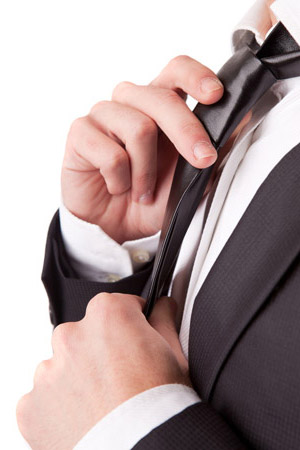Dressing for Job Interviews
 It’s All about How You Dress
It’s All about How You Dress
As a current job seeker, one thing I’ve been taking careful notice to is how other candidates dress for interviews. In comparison to most candidates, I’ve been wondering if I’m overdressed. Then I remember everything I ever read about dressing for interviews: always dress to impress. First impressions can be lasting impressions so it’s extremely important to make them your best.
Ditch the jeans, Capri pants, Bermuda shorts, tight fitting cloths, flip flops and sandals. Remove any facial piercings. This is neither a trip to the beach nor a leisurely day of errands.
Men should wear a conservative, solid color suit. Navy blue and charcoal grey are preferable suit colors. Some dark brown suits are okay, but should generally be avoided. Earth tones aren’t formal enough and shouldn’t be worn. Black suits are plenty formal but are inappropriately flashy, like something you’d wear to a wedding. Pin stripes are okay, but only if they are subtle as they add a touch of flair, show a sense of adventurousness, and can liven up a gray suit. Suit jackets should fit so that they can be easily buttoned without any real tug marks across the fabric. The arms should be long enough so that about a ¼ inch of your dress shirt can be seen past the cuffs when your arms are relaxed at your side. White shirts are the safest and most conservative. Cream, almond and pale-blue shirts are also fine as long as they are solid without stripes or patterns. Point collars are recommended for an interview, but spread collars are okay too. Avoid cotton-blend shirts, polyester or any shiny shirts. Shirts should be 100% cotton. Ties should be between 2 ¾ and 3 ½ inches wide and should have a traditional pattern. Wear ties made of pure silk. Skip “trendy” ties or anything made of something other than silk. Your tie should reach, but not exceed, the top of your belt buckle. Windsor knots are generally preferred at job interviews because they’re considered the most conservative, but four-in-hand knots are fine as well. Knots should be neat and fit within the space created by your choice of collar. Your belt should always match your shoe color. Suspenders are fine, but avoid belt buckles. You should wear black, oxblood or brown leather shoes. Black shoes are strongly recommended because they match almost with any suit and are easy to coordinate with a belt. Avoid loafers. Socks should be dark and coordinate with your suit. They should be long enough so that no one can see your leg when you’re seated. Go sparingly on the cologne or use none at all. You don’t want to smother in interviewer in your cologne.
Women should wear a conservative two-pieced matched pantsuit or skirt suit. Dresses and dress pants with a nice button down blouse are also acceptable. Navy blue, charcoal grey, khaki, and black are preferable suit, dress, and pant colors. Very subtle weave patterns and plaids will work. Skirts and dresses should be knee length or longer. Avoid wearing micro-skirts, mini-skirts, and mini-dresses. Underneath the suit jacket, wear a white tailored shell or blouse of good quality knit. The same goes for your nice button down blouse if you’re opting for dress pants. Be sure not to show any cleavage. Shoes and hosiery should be neutral in color. Go with flats or heels that are black, beige, taupe, and tan are always a safe bet. Heels should never be more than a couple of inches in height. Shoes should always be closed toe. Nude is the best choice for pantyhose. Avoid high contrast between your suit and hosiery color. A watch is fine, but remember to keep your choices simple and always lean toward conservative. Avoid extremes of style and color. It depends on the industry; some may go for more creativity, but generally keep it simple when it comes to jewelry. Keep make-up conservative as well. A little is usually better than none. Nails should be clean and well groomed. Avoid extremes of nail length and polish color. As with men and cologne, go sparingly on the perfume or use none at all. You don’t want to smother in interviewer in your perfume.
When it comes to briefcases, portfolios, and handbags, try to use leather. Avoid large and bulky briefcases, portfolios, and handbags. Make sure whatever you’re carrying coordinates with what you’re wearing. Leave the backpacks at home.
Hair should be tidy and ideally low maintenance – i.e., back from the face, not elaborate. Men, short hair is generally preferred. Facial hair is discouraged, although well-groomed mustaches are usually okay.
You want to come across professional and not high-maintenance or fussy in your appearance. Don’t try to look dowdy or older than you are. Appear confident. The way you’re dressed will help sell yourself during the interview.






 ';
}
?>
';
}
?>